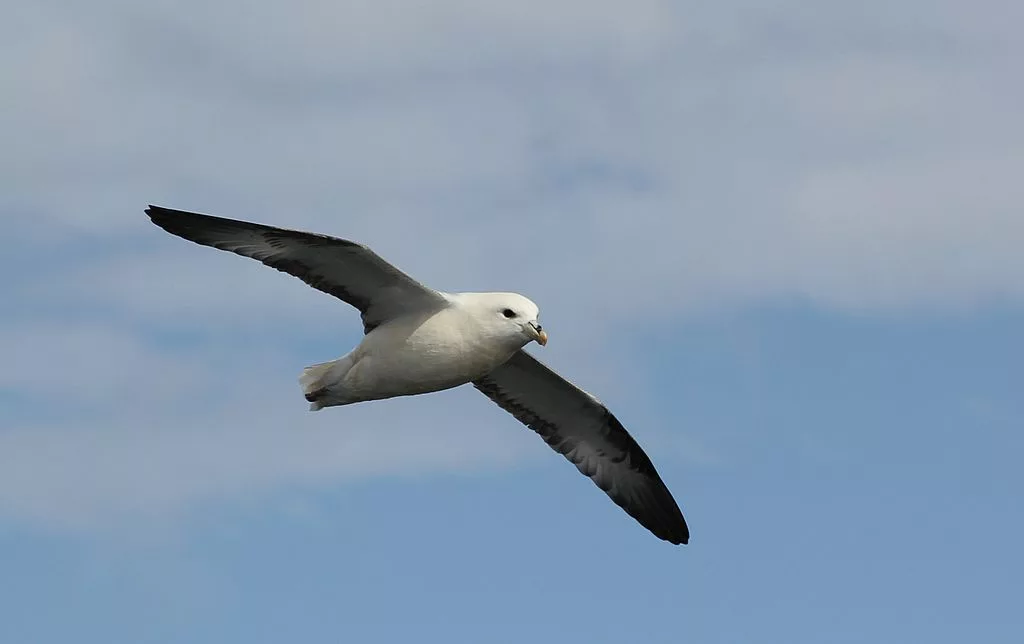A northern fulmar (Fulmarus glacialis) in flight. Avenue, CC BY-SA 3.0, via Wikimedia Commons
Microplastics have received a lot of attention for their impacts on the environment, and increasingly, on human health. Along with fears that these tiny pieces of plastic shed into the environment may enter our bodies, recognition of the damaging effects of microplastic pollution has led to an increased demand for better regulation.
New research suggests it’s not just for our own health that we should be worried. A new study led by zoologist Gloria Fackelmann at Ulm University in Germany found that microplastics ingested by seabirds have significant impacts on their health.
Published last month in Nature Ecology & Evolution, the research looked at two seabird species known to ingest large amounts of microplastics. In particular, the researchers wanted to establish whether microplastics in the gut were affecting the healthy microbes found there.
The gut microbiome—whether human or avian—is essentially its own ecosystem, made up of a diversity of species all with their own specialism. Having many of these species, and a stable balance between them, is crucial to maintaining a healthy gut.
Fackelmann and her team investigated whether microplastics were impacting this delicate balance. They collected dead specimens of two species—Cory’s shearwaters (Calonectris borealis) and northern fulmars (Fulmarus glacialis)—from sites that were part of ongoing studies (the Azores Archipelago, Portugal, and Baffin Bay, Canada, respectively). The birds were dissected, and two types of sample were taken.


Birds’ digestive systems are structured differently from humans, but, like ours, contain a community of microorganisms that in healthy birds contribute to gut function. Researchers sieved the contents of each bird’s proventriculus – the organ where digestive enzymes are secreted—to extract microplastics and recorded their mass. They also took swab samples to extract genetic material to identify the microorganisms present.
Across both species, birds with greater amounts of microplastics in the gut had on average fewer “commensal microbiota”—those healthy microbes whose presence is beneficial to gut health. Alarmingly, more microplastics also meant more pathogenic and antibiotic-resistant microbes, as well as those able to digest plastic. These results led the authors to suggest that microplastics may act as a “vector” for zoonotic pathogens, facilitating their spread between populations.
The implications of this, the authors argue, “are far-reaching.” Little is known conclusively about how human gut health is affected by the accumulation of microplastics, but these results do not seem encouraging. The possibility of microplastics acting as a vector for pathogens is especially worrying, given the ubiquity of microplastic ingestion among humans and other species we surround ourselves with. If this facilitates transmission of pathogens from one species to another—zoonoses—we might have just identified a major risk for public health.
As zoonoses and the state of wildlife health in a globalized world gain more attention, the search for causes and origins of possible future zoonoses is gaining importance.
Fackelmann et al. (2023)
The study is also yet another sign of how environmental pollution is affecting wildlife, adding a new group of animals to the list of those known to be affected by microplastics. And of course, it’s especially bad news for seabirds, a group already suffering from a variety of anthropogenic impacts.
A 2015 analysis of monitored seabird populations estimated that seabird numbers had suffered a global decline of 70% since 1950. Species may be affected somewhat differently, but common causes include competition with fishermen for prey, predation by rats, and mortality from bycatch. Balearic shearwaters, a relative of the Cory’s shearwater studied by Fackelmann and colleagues, suffer such catastrophic mortality from bycatch on fishing lines that they have been predicted to go extinct in the next 40-60 years.
These trends have been further exacerbated by last year’s outbreak of highly pathogenic avian influenza (HPAI)—a particularly nasty bird flu that emerged from poultry farms. Some species were particularly badly hit—the great skua (Stercorarius skua), for instance, is estimated to have lost 7% of its global population.
Seabirds are slow to recover from population decline because of their long generation times and low rate of reproduction. Procellariforms, the group that includes both species studied here as well as petrels and albatrosses, are particularly vulnerable as they tend to only lay one egg per year, reach sexual maturity relatively late compared to other birds, and often take whole years off breeding to manage their own condition.
Despite these threats, conservation efforts and international cooperation have produced some recent wins for seabirds. In 2021, an agreement between 15 countries renewed and extended the OSPAR Convention’s protection of the North-East Atlantic, covering an area the size of the UK and Germany combined that is known to be a foraging hotspot for over 6 million Atlantic seabirds. And many new projects are underway to eradicate invasive predators like rats and ferrets from seabird colonies, such as on Rathlin Island in Northern Ireland, and Marion Island in the Indian Ocean.
That microplastics are bad for wildlife is not news—but learning more about the extent of their effect on animals’ physiology, as well as their potential influence on zoonoses, should give more ammunition to those looking to draw the world’s attention to the problem of plastic pollution. As such, Fackelmann and colleagues’ study offers yet more evidence for action to be taken against microplastics. It also highlights how methods developed in other biological disciplines—in this case genetics—are rapidly revolutionising the wider field, opening the door to increasingly interdisciplinary studies—and insights.





